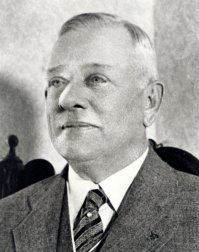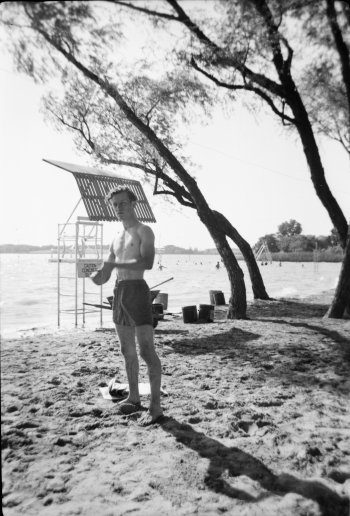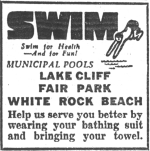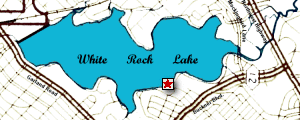|
In 1981, the White Rock bathing beach Bath House, which sat vacant and unused for nearly thirty years, reopened as the Bath House Cultural Center. Today in former locker rooms, where patrons showered after swimming in the lake, the BHCC hosts art exhibits, plays, concerts, and a variety of similar activities. For more information, see the official Bath House web site, where you can obtain information about upcoming events.
 Bath House History Bath House History
In 1930, during the administration of "hot dog" Mayor J. Waddy Tate, a bathing beach, complete with sand, was established on the eastern shore of White Rock Lake. The Art Deco-style bath house seen here was built so that swimmers could have a place to change from their street clothes into their swimming suits and to shower afterward. Refreshment stands, located on the lower level, sold hamburgers, hot dogs, and soft drinks to hungry and thirsty patrons. The structure, designed by the Dallas architectural firm of Carsey and Linskie, is made largely of concrete, covered with white plaster.
A concrete "apron" or slab below the water line, several yards wide and extending out into the lake, made for a firmer footing than the mud and the silt of the lakeshore. On the day the beach first opened, it was only about two-thirds covered, owing to the drought that then prevailed. At that time, the level of the lake was about three feet below the top of the spillway. The apron, along with a concrete diving platform and the light poles that illuminated the swimming area are still in place nearly fifty years later!
In an early attempt to sanitize he water, a four-cylinder motor boat criss-crossed the swimming area at night, dumping "large doses of chlorine" into it. Later, "a pipe and nozzle system which rested on the concrete slab" was used. "With both methods," remarked a critic, "a chlorine reading taken immediately would register sufficient, otherwise the currents of the lake would take it away." In short, "an attempt to meet sanitation requirements for White Rock Lake was the same as trying to chlorinate the entire lake waters."
 During the mid-1930s, visitors to White Rock beach could also enjoy a Sunday afternoon music concert performed by Babe Lowry and her all-girl band, the "Rhythm Sweethearts." The "Sweethearts" also played for the nightly dances at the adjacent dance pavilion. Beach visitors could also watch fireworks bursting over the lake on the Fourth of July, thrill to motorboat races, or attend the "Miss Dallas" beauty pageant, which in 1931 was judged by none other than famed swimming champion and Tarzan movie actor Johnny Weismuller. During the mid-1930s, visitors to White Rock beach could also enjoy a Sunday afternoon music concert performed by Babe Lowry and her all-girl band, the "Rhythm Sweethearts." The "Sweethearts" also played for the nightly dances at the adjacent dance pavilion. Beach visitors could also watch fireworks bursting over the lake on the Fourth of July, thrill to motorboat races, or attend the "Miss Dallas" beauty pageant, which in 1931 was judged by none other than famed swimming champion and Tarzan movie actor Johnny Weismuller.
White Rock Beach was open each summer for twenty-three years (usually from 8:30 a.m. to 10:30 p.m. daily, generally June through August) but just as drought led to the creation of the lake itself, so too did it spell the end of this popular recreational spot. Monday, September 1, 1952 was the last day the beach was open to the public. The following year, during a major drought, it became necessary to start using White Rock Lake as a water supply again and although the drought eventually ended, the beach was never reopened. In 1951 Mayor Tate's widow, Blanche, wrote a poem (see right), which was published in the Dallas Times Herald, recalling her late husband's role in bringing the beach and bath house to White Rock Lake.
|
|
Advertisements like the one shown below appeared in local newspapers throughout the 1930s and '40s, urging Dallasites to "swim for health and for fun." But it was no doubt the weather that prompted most folks to come out to the lake. In an era where only movie theaters and some office buildings were air conditioned, the cool lake breezes offered some measure of relief from the hot Texas sun. On one particularly broiling summer Sunday in 1946, 4,500 bathers crowded White Rock Beach, prompting beach manager Doyle Smith to remark, "They slugged us."
The bath house and bathing beach were first opened to the public on Saturday, August 9, 1930 at 3 p.m. On that day, several hundred persons paid the nominal admission fee (25 cents for adults and 15 cents for children) to take "a 'dip' in the cool waters of the reservoir." The beach was officially dedicated the following Saturday. At the request of Mayor Tate, known as a friend of the "plain people," bus service was extended from the Junius Heights trolley line to the White Rock area, "five blocks further to the new muncipal boathouse." At that point, bathers could "transfer to fast motorboats for the cross-lake jaunt to the bathing beach." Of course, people who owned cars could drive themselves by going out Garland Road and following East Lawther Drive to the Bath House.
|
|
BLANCHE TATE'S POEM
in honor of her husband, Mayor J. Waddy Tate
All you bathers on the beach at White Rock
Should bow your heads in honor of the man
Who made it possible for you to frolic
In that pure water on the clean white sand.
He was ever thoughtful of the comfort
Of those who couldn't get away to play
And worked so hard to get the problem over
So you could cool off at the end of day.
By swimming with your family after eating
Where the cost is cheaper in a way
To spend an evening, innocent in pleasure
After hard work in the sun all day.
He was the poor man's friend, but loved them all
From every part of Dallas, and the state -
Where he was born; and loved the title, "TEXAS,"
As some would call him, in a jovial trait.
You people loved him too, for it was proven.
'Twas not so very many years ago
You put him in an office over thousands
In his home Dallas, where he loved it so.
So now he's forgotten, but will never be forgotten -
As long as White Rock ripples that clean shore,
Where thousands bathe, and spend a pleasant evening,
Their thoughts are with him now, as days of yore.
|

|